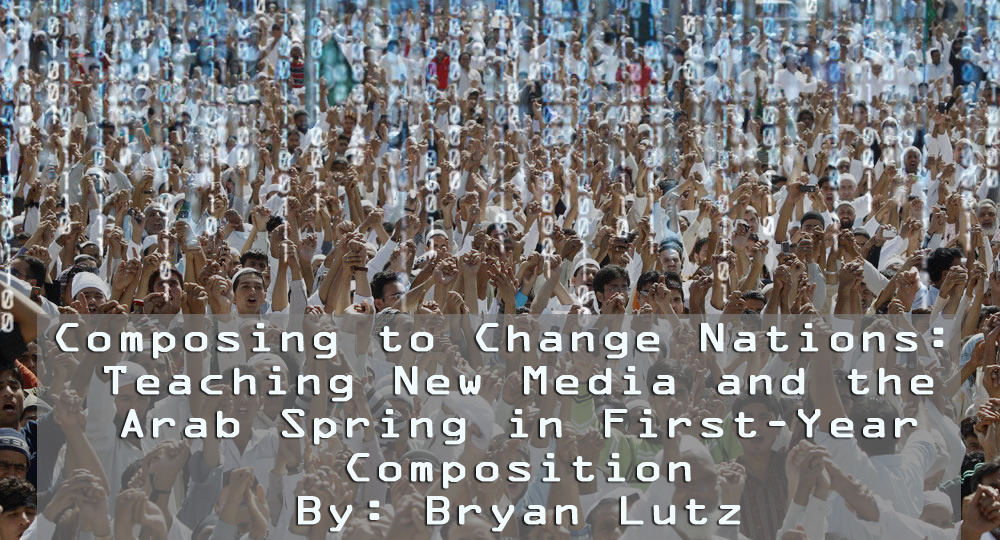Assignment
Goals
In addition to the Arab Spring this assignment is influenced in part by the work of Charles Tryon (2006), who designed both a class blog and a blog assignment that unexpectedly brought outside voices into his class. His blog assignment has three parts. First, students find a political blog of their choosing. Second, they use the rhetorical triangle to analyze the blog’s efficacy, intended audience, and purpose. Third, they post a short response to their own blog that included a hyperlink to the blog they analyzed. These responses were posted on a blog created by Tryon. By his account, this practice was successful in the ways he intended. However, by students hyper-linking to the blogs they analyzed, the class unintentionally drew the attention of the blog’s authors. By Tryon’s account: “These bloggers then responded to my assignment in their own blogs, with responses ranging everywhere from flattery to snark, usually a mixture of both” (pp. 129). This surprise audience had a profound effect on Tryon’s students who “took this new context into account” and which inspired a “public discussion [that] allowed [Tryon] to address in explicit and specific ways the boundaries between the classroom and the wider public” (pp. 130). Seizing the opportunity, Tryon then encouraged his students to generate course topics using the sources they found (pp. 131), and he argues that both his students writing and his own grading practices were improved because of the added considerations of a public audience. I was inspired by this work to use blogging for a similar purpose.
Blogs as a genre afford a template that is easy to use without being too prescriptive. As a space for composition blogs are user-friendly interface for students to combine text, image, and video in order to represent themselves through the composition of essay-length, multimodal arguments. Blogs also allow students to publish their arguments where they can be easyily shared with other bloggers and advocacy groups, as well as more personal audiences through Facebook and Twitter. This admittedly works differently from the Arab Spring, where social networking sites were the primary templates for constructing arguments. However, blogs are an avenue for reaching global audiences because they provide a URL address that can be seen by anyone on the web. These outside audiences not only offer opportunities for revision, but also opportunities for student agency beyond the academy as their compositions contribute to both local and global conversations. The strategy here is to put first-year composition students in touch with authors and advocacy groups already working for social justice. The ultimate goal is to take the class beyond the realm of writing for just the academy and moving toward a model of composing where civic engagement is a focus. If they are willing, students can employ the same innovations demonstrated during the Arab Spring and experience how to utilize both the affordances and the velocity of new media to give them agency beyond the classroom; this assignment aims to teach students how, if the conditions are right, they can compose to change nations.
It would be impossible to offer this assignment without describing the classroom environment I strive to create. Obviously there are numerous ways to instruct first-year composition, which are often tailored to the instructor’s interests and pedagogical preferences; however, I find that a focus on problem solving, collaboration, and rhetorical strategies are ideal for achieving the goals of this assignment. I offer this description not as a manual for how the assignment should be conducted, but as an example of how this assignment could fit within a first-year composition course. The link below provides the assignment prompt; an instructor is welcome to have this if they would like to try this assignment in their own classes. In the next section, I provide a description of how this assignment can work in the classroom by categorizing it into four sub-goals:
1.) Identity:Create a unifying identity that will afford students a sense of solidarity with their work
2.) Questions: Search for a problem of contemporary relevance that is of interest to them either personally or in their chosen major and connect with a blog community discussing their issue
3.) Global Turns: To assess and combine the conventions of a blog community with the conventions of writing an academic essay; and to both analyze and employ multiple modalities in order to effectively engage an audience of their instructor, their peers, and beyond
4.) Civic Engagement: Use new media to afford students the ability to reach an audience outside the classroom with the expressed intention of joining their conversation
